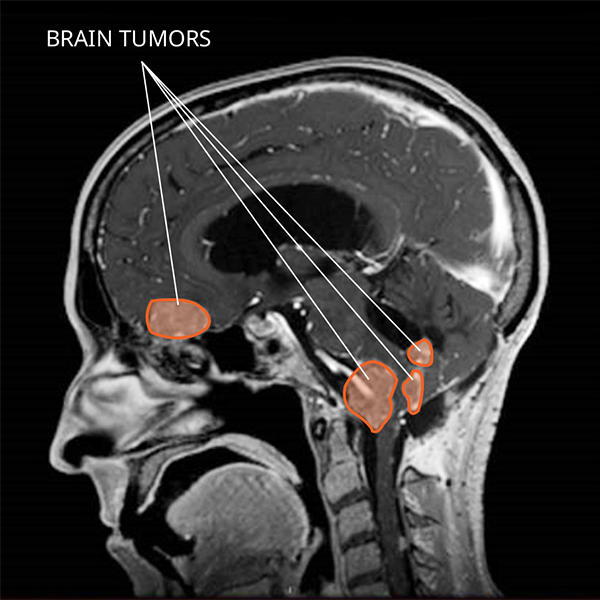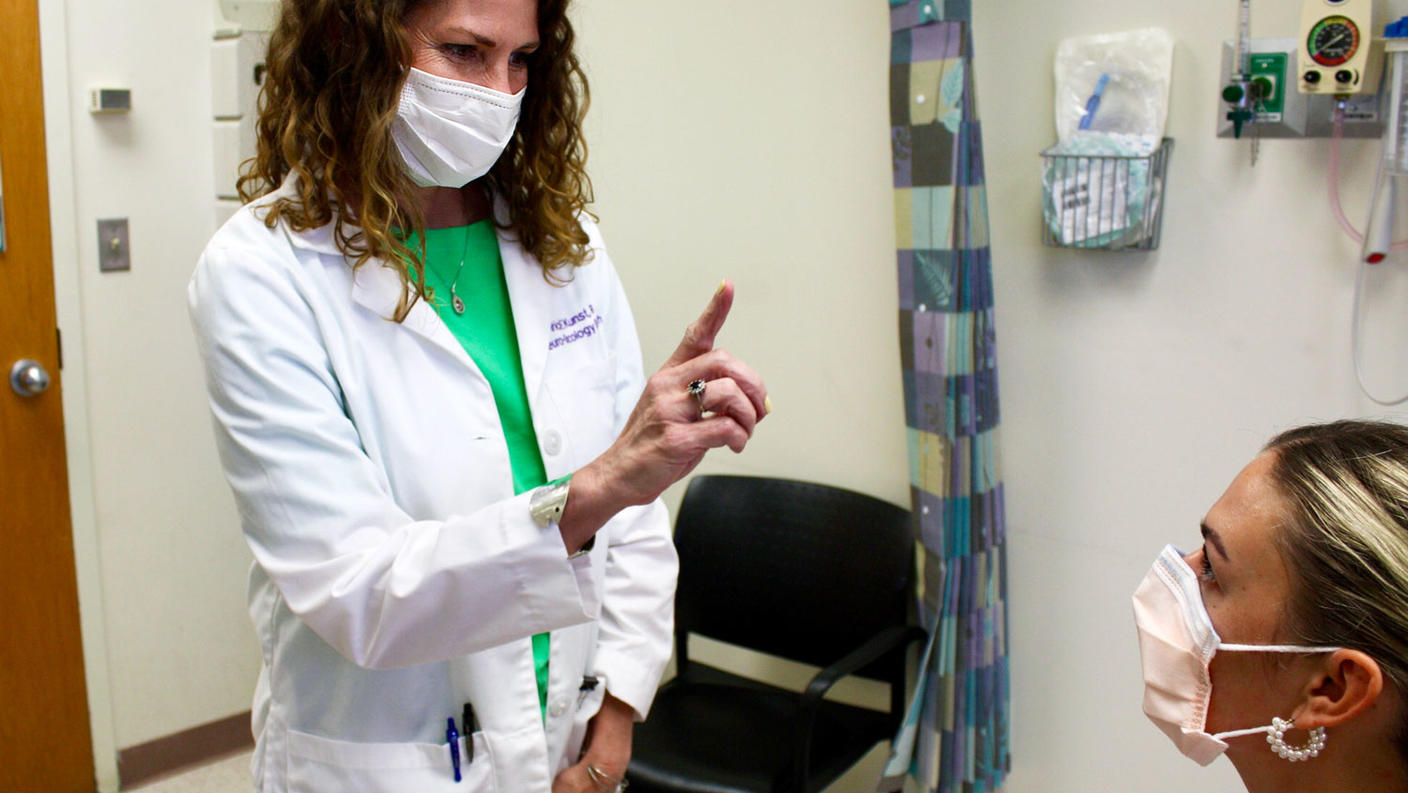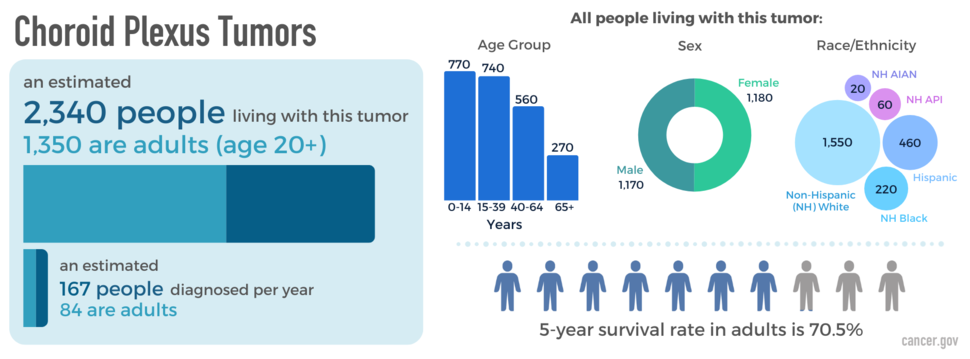Choroid plexus tumors are primary central nervous system (CNS) tumors. This means they begin in the brain or spinal cord.
To get an accurate diagnosis, a piece of tumor tissue will be removed during surgery, if possible. A neuropathologist should then review the tumor tissue.
What Are the Grades of Choroid Plexus Tumors?
Primary CNS tumors are graded based on a tumor tissue analysis performed by a neuropathologist.
Choroid plexus tumors are grouped in three grades based on their characteristics: grade 1, 2, or 3 (also written as grade I, II, or III).
- Grade 1 choroid plexus tumors are benign (non-cancerous) tumors called choroid plexus papillomas. This means the tumor cells grow slowly.
- Grade 2 atypical choroid plexus papillomas are mid-grade tumors and are also benign. These tumors have a higher chance of coming back in the same location after being removed.
- Grade 3 choroid plexus carcinoma are malignant (cancerous). This means they are fast-growing tumors that are more likely to spread to other areas of the CNS.
What Do Choroid Plexus Tumors Look like on an MRI?
Choroid plexus tumors typically appear in the ventricles (fluid-filled cavities) of the brain. They usually have irregular borders and a “cauliflower-like” appearance. These tumors tend to have patchy enhancement with contrast on a magnetic resonance imaging (MRI) scan. Choroid plexus carcinomas may also show some swelling around them. Hydrocephalus—an abnormal build-up of fluid—is very common.
What Causes Choroid Plexus Tumors?
Cancer is a genetic disease—that is, it is caused by certain changes to genes that control the way our cells function. Genes may be mutated (changed) in many types of cancer, which can increase the growth and spread of cancer cells. The cause of most choroid plexus tumors is not known. Genetic changes, notably mutation of the TP53 gene, have been linked to the formation of grade 3 choroid plexus carcinomas in about 50 percent of cases. Rarely, certain genetic changes that can be passed down through families have been linked to a higher chance of developing choroid plexus carcinomas.
Where Do Choroid Plexus Tumors Form?
Choroid plexus tumors arise from a structure in the brain called the choroid plexus. It lines the ventricles of the brain and its primary function is to produce cerebrospinal fluid (CSF). Choroid plexus tumors almost always form within the ventricles. However, they can also form in other regions of the CNS.
Do Choroid Plexus Tumors Spread?
Grade 1 and 2 choroid plexus tumors rarely spread to other areas of the CNS. In contrast, up to one-fifth of grade 3 choroid plexus tumors have already spread to multiple CNS locations at the time of discovery.
What Are the Symptoms of a Choroid Plexus Tumor?
Symptoms related to choroid plexus tumors depend on the tumor’s location. People with choroid plexus tumors may have hydrocephalus—increased pressure within the skull due to the production of too much CSF or blockage of its normal flow.
Signs and symptoms of hydrocephalus may include:
- Nausea
- Vomiting
- Irritability
- Headaches
- Blurred or double vision
- Sleepiness
- Seizures
Who Is Diagnosed with a Choroid Plexus Tumor?
Choroid plexus tumors occur in both children and adults but are more common in children during the first year of life. An estimated 2,340 people are living with this tumor in the United States.
What Is the Prognosis of a Choroid Plexus Tumor?
The likely outcome of the disease or chance of recovery is called prognosis. Prognosis is based on tumor grade, location, tumor type, extent of tumor spread, genetic findings, the patient’s age, and tumor remaining after surgery (if surgery is possible).
The relative five-year survival rate in adults (age 20 and older) in the United States for choroid plexus tumors is 70.5 percent. However, there are many factors that affect prognosis. These include the tumor grade and molecular type, the person’s age and health when diagnosed, and how they respond to treatment. If you want to understand your prognosis, talk to your doctor.
What Are the Treatment Options for Choroid Plexus Tumors?
The first treatment for choroid plexus tumors is surgery, if possible. The goal of surgery is to obtain tissue to determine the tumor type and remove as much tumor as possible without causing more symptoms.
Treatments after surgery may include radiation, chemotherapy, or clinical trials. Clinical trials test new treatments, such as chemotherapy, targeted therapy, or immunotherapy drugs. Treatments are decided by the patient’s health care team based on the patient’s age, remaining tumor after surgery, tumor type, and tumor location.
Open Clinical Studies for Choroid Plexus Tumors
- PLX038 in CNS Tumors
- Immune Checkpoint Inhibitor Nivolumab for Patients with Rare CNS Cancers
- ONC206 for Patients with Rare CNS Neoplasms
Learn More
- Video: Clinical Trial Tests Nivolumab for Patients with Rare Brain and Spine Cancers
- Working Through a Life-Changing Rare Brain Tumor Diagnosis
- New Study Reveals Data on Rare CNS Tumors to Inform Clinical Care and Evaluate Novel Cancer Treatments
- Classifying Brain and Spine Tumors More Precisely to Improve Patient Outcomes and Care
- Read our NCI-CONNECTions Blog for recent news and information on rare brain and spine tumors.
Referrals
NCI-CONNECT doctors and nurses work with you and your primary doctor to collaborate on a comprehensive care plan that treats your brain or spine tumor. They will also help you cope with the physical and emotional aspects of your diagnosis. Learn about requesting a consultation >


